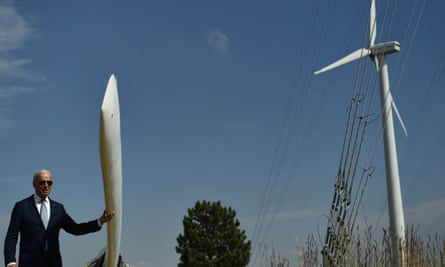
Europe and the US should work with China. Joint climate action could be a win-win

From deals on electric cars to investment in solar panels, there is room for all sides in the global green industrial revolution
Our polarised world is failing to tackle the climate crisis at the required speed. The only way to reverse this catastrophic situation is to get the three largest historical emitters – the US, Europe and China – to join forces, directly or indirectly, to accelerate the global shift to green energy.
After months of rising tensions, the possible visit to Washington of the Chinese foreign minister, Wang Yi, later this month could pave the way for a highly anticipated but still unscheduled summit between presidents Joe Biden and Xi Jinping, and kickstart a reset.
Negotiators will have their work cut out. For each of the three power blocs regards the others with intense suspicion; they each think of themselves as the good while the other two are the bad and the ugly, in terms of climate inaction.
China blames the US for actively pushing deglobalisation in a desperate attempt to slow down the Chinese green industrial revolution, while seeing Europe as almost as bad with its carbon border tax and investigation into Chinese electric car exports.
The Biden administration is suspicious of China’s success in gaining a dangerous edge in clean tech supply chains that may be weaponised against the west at any time. Washington fears that Brussels will use its EU carbon border tax to try to slap a tariff on American steel and aluminium.
Europe accuses China of distorting global trade and wants to “de-risk” its relationship with Beijing. But the EU also thinks the US is playing dirty with its Inflation Reduction Act (IRA) and trying to lure clean tech investment from Europe. This green geopolitical stalemate must be sorted out.
In a best-case scenario, the US, Europe and China would step up direct collaboration, actively promoting joint clean tech investments or joint ventures. Realistically, given the current geopolitical landscape, they would at least refrain from disrupting the indirect collaborations that have developed over the past two decades thanks to integrated supply chains.

In one way or another, it is essential to get them together on the climate crisis, because the three powers jointly account for 53% of annual global emissions, 60% of GDP and 40% of goods imports. Over the past two decades they have between them dramatically driven down the cost of solar and wind energy so renewables will underpin much of the global green transformation. Replicating this success story to achieve climate neutrality should be the top priority.
The three-way stalemate can be unlocked. China has a comparative advantage in some clean technologies. It has developed a strong position in solar panels and – as is becoming obvious to all – electric cars. It can achieve economies of scale that others may never be able to develop, while at the same time it has increasing levels of innovation. It has a good combination of renewable energy potential and vast land availability.
The US and Europe are right to be concerned about the concentration of global clean tech supply chains in China. It represents a risk, and not only for geopolitical reasons. Think of natural disasters: China is particularly exposed to the impact of the climate crisis, and extreme weather events in one or two of its main manufacturing regions alone could disrupt global supply chains for weeks. China itself would never become dependent on the single supplier of a critical technology or commodity.
The US and Europe are also right to be concerned about the job implications of the green transition in their countries, and China should accept this. The green transition will only be achieved if it has widespread social and political support. This is particularly challenging in liberal democracies, where the risk of populist parties going after the green agenda for short-term electoral gain is growing.
Many carbon-intensive jobs in the US and Europe will have to be phased out in the coming decades. Replacing them with good green jobs is the key to ensuring public support. To be clear, neither the US nor Europe can afford to lose their car industries: they are just too important for their economic and social fabric. Neglecting this could cause a public backlash against the move to net zero. And that should also represent a risk for China, given its large volume of clean tech exports, namely to Europe. Beijing needs to understand that certain concerns in Washington, Brussels and other European capitals are truly driven by domestic political realities rather than being part of a China-bashing agenda.
after newsletter promotion
So how to square the circle here? The three powers need first to understand each other’s needs and priorities, and on that basis build a constructive dialogue. The scale of the global green transition is so large that there is space for everyone. On tomorrow’s global roads there will be ample space for Chinese electric cars, as well as for European and American ones. Importantly, there will also be space for Indian, South African or Brazilian ones too, because China, the US and Europe are not the only ones in need of ensuring that the green transition represents an economic opportunity.
The second step is an agreement on green subsidies that could work for all sides. This could be done either as a three-way agreement or in the framework of the World Trade Organization.
The third step is to develop new win-win industrial collaborations, mindful of the fact that for both the US and Europe the key problem is not ownership, but location of investments. For example, more Chinese battery or car manufacturing located in Europe would be welcome. Likewise, new joint ventures could be explored between Chinese and European carmakers. Volkswagen, for example, already has several factories in China. Chinese companies may well turn out to be important beneficiaries of Biden’s core piece of climate legislation, the Inflation Reduction Act. US companies such as Tesla have built a presence in China
As the energy-climate-industrial policy nexus becomes the cornerstone of the green transition, the US, Europe and China share an important global responsibility. If they don’t move, the world will not move. This would have dramatic consequences for all.
-
Simone Tagliapietra is a senior fellow at the Brussels-based thinktank Bruegel